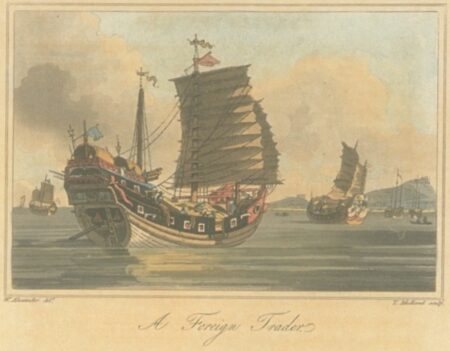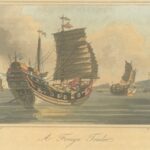Junk ship
Ship
Ancient
Quick Facts:
Besides having a cool name, the sturdy, lightweight junk is known for being the first ship to feature a rudder mounted on its stern for steering. The Chinese junk ship was among the most powerful and easily navigable ships in the ancient world.

Chinese junk 1804
A Chinese junk depicted in Travels in China: containing descriptions, observations, and comparisons, made and collected in the course of a short residence at the Imperial palace of Yuen-Min-Yuen, and on a subsequent journey through the country from Pekin to Canton, page 59 by John Barrow.
{{PD-Art|1804}}
The Chinese and other Asian cultures have used the junk ship for millennia. The first known reference to ships like the junk was around 2800 BCE under the Chinese emperor Fu Hsi. Junks had many uses in ancient Chinese culture, including fishing, transportation, trading, warfare and the exploration of Southeast Asia. Along with its innovative rudder steering system, junks were built to withstand rough seas, to be easy to maneuver, and to move quickly. The strong build of these ships allowed Chinese explorers to venture far and wide. Ancient Chinese coins have been found in India and even the eastern shores of Africa! Evidence of junks have been recorded in the writings of Muslims on the Euphrates River in the 7th century CE, and fleets of junk ships were recorded by Marco Polo in the 13th century. When Marco Polo wrote about these ships, most were quite large, with 50 to 60 cabins onboard. By the 15th century, however, junks had become colossal in size! These massive, well-built ships were said to be 400 feet long and 160 feet wide (that’s 40 stories from bow to stern and 16 stories from starboard to port)!
One of the unique features of the junks were the shape of their sails, which were very different from those of Western ships. Chinese junks were not square-rigged; they had elliptical, curved sails, which were reinforced with inner bars made of bamboo. Because the bamboo kept the sails strong, less rigging was needed. It also prevented the sails themselves from fraying and rotting as quickly as they otherwise would have.
The ingenuity and strength of these ships have allowed them to continue to be used today. Some junks are used for tourism; however there are still junks that are used for fishing and trade in the coastal waters and rivers of China, Japan, and Indonesia. Although the typical junk has shrunk in size from 400 feet to about 70 feet, they are still large enough for some families to live in them.
- A Chinese junk depicted in Travels in China: containing descriptions, observations, and comparisons, made and collected in the course of a short residence at the Imperial palace of Yuen-Min-Yuen, and on a subsequent journey through the country from Pekin to Canton, page 59 by John Barrow
-
Waldman, Carl, and Alan Wexler. Encyclopedia of Exploration, Vol. 1-2. New York: Facts On File, 2004.

